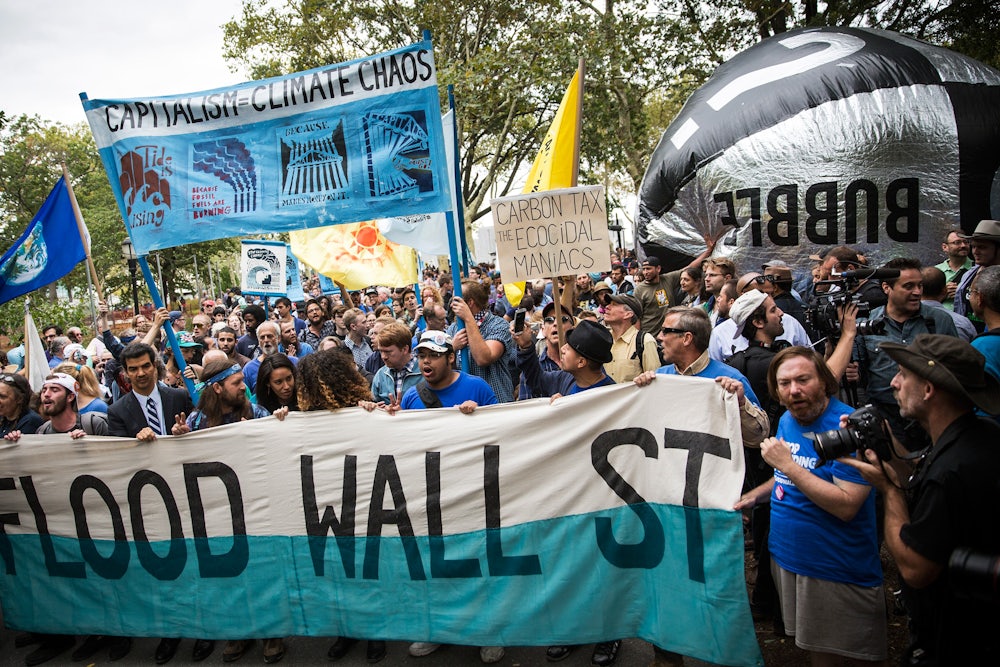Read enough financial news these days and you’ll see a lot of stories about “ESG investing,” which stands for “environmental, social, and governance.” The trend is meant to encourage, broadly, socially responsible and environmentally friendly investing, rather than a pure focus on how much money an investor earns. At the most basic level, ratings firms grade companies on their impact on the environment, the quality or equity of their internal governance, and, uh, their impact on “society.” Then a bunch of those companies might get bundled together in a fund that promises a high overall ESG rating. What ties those three factors together? Mainly just a wish to make money investing without feeling bad about it and a desire to profit from people with that wish.
To get a sense of what this stuff is for, or at least what you, the layperson, are meant to think it’s for, this 2015 Atlantic story, by James Fallows, on Al Gore’s investment firm, is a fine introduction to the basic tenets of ESG investing, as financial institutions want it to be understood by the masses. The pitch could not be more geared to that magazine’s audience, in fact: What if you could save the world and continue making money off your money, forever?
Gore and his partners named their strategy “sustainable capitalism,” which is certainly friendlier to the ear than “ESG,” but the concept is the same. As Fallows explains, “The idea is that if some tenets of ‘long term’ and ‘value based’ investing are extended to include the environmental and social ramifications of corporate activity, the result can be better financial performance, rather than returns that are ‘nearly as good’ or ‘worth it when you think of the social benefits.’” In other words, greed and good need not be exclusive.
This gets at one of the important things to keep in mind about ESG investing: It is an investment strategy, not a political movement. The positive societal outcomes are secondary. ESG investing, like crypto, is a major business trend, with Bloomberg predicting $1 trillion entering ESG funds over the next five years.
That should be great news. Leveraging the self-interested desires of rich people to passively earn money in order to invest in global sustainability seems like a win-win deal. Sure, the rich might keep getting richer, but perhaps the way they get richer will stave off our coming climate apocalypse. Unfortunately, the other thing you learn if you read enough financial news these days is that none of the feel-good stories are all that true. Even if there are fortunes to be reaped in batteries or wind power, “sustainable capitalism” is still much more about the capitalism part than the sustainable part.
As I alluded to earlier, the category itself is frankly incoherent. It would make sense to rate companies purely on their carbon emissions (or, as we’ll discuss later, a company’s exposure to climate change–related risk). Instead, because of the intermingling of unrelated “responsibility” factors in the grade, the rating algorithms might aggregate an environmental score with one based on, for example, how many members of a company’s board are women, and then spit out an arbitrary grade.
A 2019 paper from MIT Sloan School of Management on ESG rating divergences studied the scores given out by six rating firms and found that, while they chose widely differing things to measure, there were a few “lowest common denominator” categories that each agency included in its ratings. Those are “Biodiversity, Employee Development, Energy, Green Products, Health and Safety, Labor Practices, Product Safety, Remuneration, Supply Chain, and Water.” The limits of this approach to “sustainable capitalism” are immediately clarified: A company might be poisoning the water, but it could still get a slight boost in its ESG score if it’s very good at training its employees to poison water more effectively.
This is not just a hypothetical scenario. A recent letter to the Financial Times by Garvin Jabusch, a working asset manager, highlighted the silliness of ESG rating systems. MSCI, one of the main ESG raters, currently gives Moderna a “BB” rating, which equates to “between average and high average.” It gives ExxonMobil—an actual oil company—a “BBB,” which is “high average.” This from a measurement that is used as a shorthand for “green” investing. As Jabusch says, if his firm were to sell the drug company and buy the oil company, “our portfolio-level ESG rating would go up.”
ESG ratings would be a faulty measure of a company’s “sustainability” even if you could trust them to accurately measure and grade all the criteria they seek to grade. But a new paper from the German business school and think tank Edhec found that exchange-traded funds claiming to rate investments strictly on the basis of climate weren’t just ineffective, they may have made the problem worse by directing more money to greenwashing than to actually effective sustainability directives. One of the paper’s most notable findings was that these funds are still fundamentally more concerned with returns than with emissions. As a press release put it: “Even though investors and managers communicate extensively on the use of climate data to construct their portfolios, this data represents at most 12% of the determinants of portfolio stock weights on average. This low percentage very clearly means that the construction of climate indices remains essentially guided by purely financial considerations.”
This gets at what ESG investing is actually for. It’s an important question, and one people involved in it are often quite slippery about answering. One version is what I laid out above: Al Gore’s pitch, that you can save the world and make money and that these goals are not just compatible, they are complementary. That is a pleasant idea—and, crucially, a great sales pitch if you, for example, run a firm that does ESG investing. This is the promise: You don’t have to sacrifice anything to invest responsibly. This represents a very real break from past political interventions in investing, as Fallows explains:
The current ethical-investment movement dates to the 1960s, when students pressured their universities to rid endowments of holdings in defense contractors or big polluters. The most famous political success of what is called a “negative screen” approach—ruling out certain categories of investment—was the anti-apartheid boycott of South African products and businesses in the 1980s and early 1990s. But all of these methods viewed “ethics” as a minus, the unavoidable cost of doing the right thing. The people at Generation, of course, contend that the “holistic” and “sustainable” view is a business plus, in the service of long-term greed.
But when not addressing a general audience, people behind ESG investing have a slightly different explanation for what they are actually doing. It is not simply investing responsibly. It is avoiding exposure to risk.
One of the larger recent scandals in the ESG investing world involves DWS Group, a German asset management firm mostly owned by Deutsche Bank. In August, The Wall Street Journal broke the news that DWS was misleading clients and investors about the scope and quality of its ESG efforts. The firm’s former sustainability chief, Desiree Fixler, was fired, she says, after raising internal concerns about the firm’s annual report, which claimed that more than half the assets managed by the company had gone through a process called “ESG integration.” In reality, according to an internal DWS assessment, “only a small fraction of the investment platform” went through any analysis related to ESG ratings. And its actual ESG process was shoddy and inadequate. One example: DWS gave a German payments company called Wirecard a B in ethics the same month it collapsed in a fraud scandal. The “G” in ESG, Fixler noted, is supposed to stand for governance.
A more representative example of the limits of ESG scores—not just faulty ones but the concept itself—can be seen in the grade DWS gave Amazon. According to documents reviewed in a more recent Wall Street Journal story, “data used to rate companies was often outdated, and involved averaging other firms’ ESG ratings” in ways that didn’t give any meaningful information about the conduct or business models of the companies being graded. To illustrate how that process failed, the Journal notes that DWS downgraded Amazon to F in March 2020. “That rating meant the company had behaved so badly that its very existence was at risk because regulators could hit it with big fines and consumers might stay away.”
That was an absurd thing to believe about Amazon in March 2020. Fixler, the fired sustainability chief, concurs. “Nothing was going to endanger the viability of Amazon,” she told the Journal.
But this betrays the actual purpose of ESG scores. Whether or not Amazon deserves, in a normative sense, an F for governance or social impact, it is clear that it does not deserve one from the perspective of “sustainable capitalism.” ESG scores do not actually reflect a company’s conduct but how likely a company is to get in trouble, from regulators or the public, for that conduct. It was fantastic to imagine Amazon’s business model being under threat in the year of pandemic lockdowns—a year so profitable for the company that its carbon emissions rose a staggering 19 percent, according to its annual sustainability report. That same year, MSCI upgraded Amazon’s ESG score from BB to BBB. Of course, as MSCI says, right there on the page: “This information is only factored into the MSCI ESG Ratings from a financial risk perspective.”
This is the essential weakness of the ESG idea. If I own shares of an energy company that sells its oil drilling operation to another company that will continue to profitably drill, refine, and sell oil, the net effect on the climate is zero, but I just boosted my ESG score by divesting in fossil fuels. If Amazon mistreats its workers but faces absolutely no chance of getting in trouble for it because of the weakness of America’s labor movement and Amazon’s easy ability to buy off local politicians, it passes its governance score. Choosing to boycott apartheid South Africa out of moral conviction is an attempt to change the apartheid system, not a bet that it is politically unsustainable. In today’s market, the seeming political resiliency of the apartheid system would be a point in its favor. “Sustainable capitalism” implies that unsustainability will eventually be unprofitable, without you, the investor, having to do anything to make that true.
The “negative screen” mentioned by Fallows was actually an acknowledgment that rich people with consciences actually do have to think about this stuff, to make decisions and even sacrifices, instead of leaving it all up to ratings agencies and fund managers insisting that the line will keep going up without anyone having to feel bad about any of it. Talking to FT, one co-author of the Edhec paper on supposedly climate-friendly ETFs put the sustainable capitalism problem very succinctly: “Given that the economy is not aligned with climate change objectives it’s very unlikely the markets would be.”
Pitching ESG as a way to beat the market seems like a clever way to convince capitalists to invest in sustainability. In practice, it has trained them to pretend their investments are sustainable. Al Gore’s Generation Investment Management has significantly outperformed the S&P 500 since 2015, when The Atlantic profiled the former vice president and his hedge fund. (Generation’s second-largest holding, as of this year, happens to be … Amazon.) Gore and his partners have helped some wealthy people become much wealthier. But Generation’s returns are not the only line on a chart that’s been trending up over those same years.
The International Energy Agency projects that energy-related carbon dioxide emissions will grow by nearly 5 percent this year, after declining by 5.8 percent last year, “the largest ever decline and almost five times greater than the 2009 decline that followed the global financial crisis.” It is not a coincidence that the value of Gore’s portfolio fell along with emissions, and that each rose again in tandem as markets began their heroic post-stimulus rally. The “sustainable capitalists” are making a bet that they can sever that link between investment returns and carbon emissions without anyone having to take a haircut. So far, it has only paid off for them.










